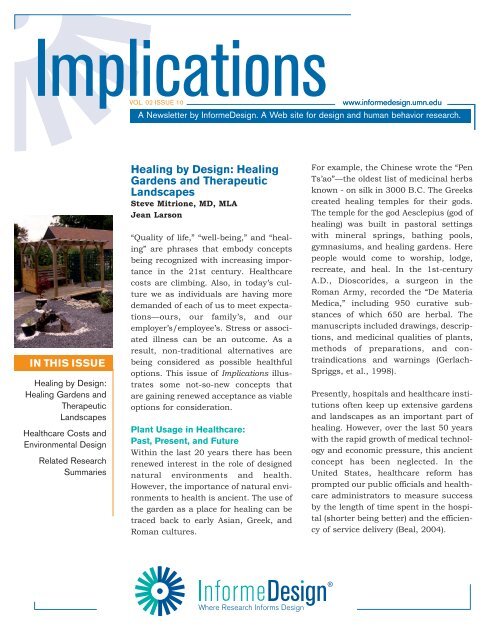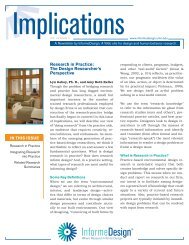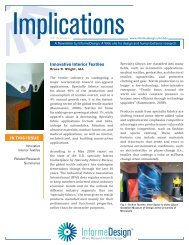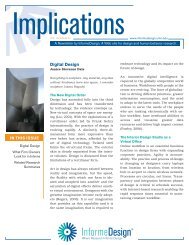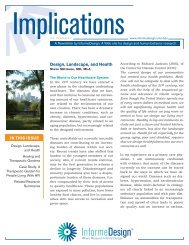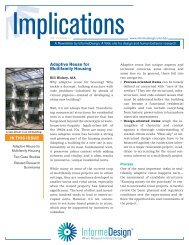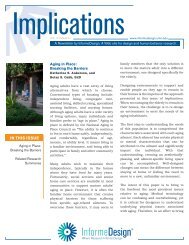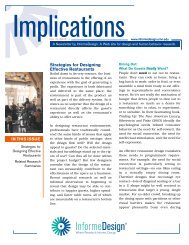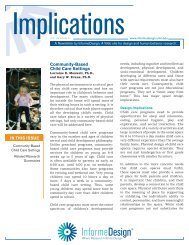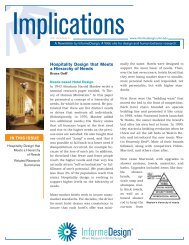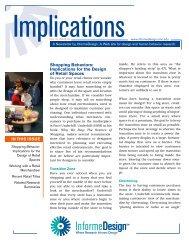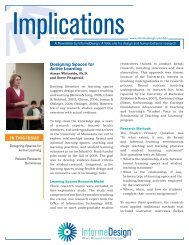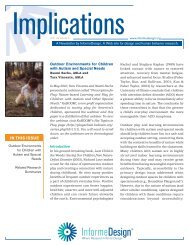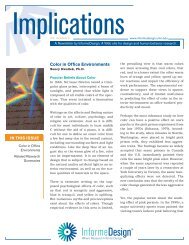Healing by Design: Healing Gardens and ... - InformeDesign
Healing by Design: Healing Gardens and ... - InformeDesign
Healing by Design: Healing Gardens and ... - InformeDesign
You also want an ePaper? Increase the reach of your titles
YUMPU automatically turns print PDFs into web optimized ePapers that Google loves.
ImplicationsVOL. 02 ISSUE 10www.informedesign.umn.eduA Newsletter <strong>by</strong> Informe<strong>Design</strong>. A Web site for design <strong>and</strong> human behavior research.IN THIS ISSUE<strong>Healing</strong> <strong>by</strong> <strong>Design</strong>:<strong>Healing</strong> <strong>Gardens</strong> <strong>and</strong>TherapeuticL<strong>and</strong>scapesHealthcare Costs <strong>and</strong>Environmental <strong>Design</strong>Related ResearchSummaries<strong>Healing</strong> <strong>by</strong> <strong>Design</strong>: <strong>Healing</strong><strong>Gardens</strong> <strong>and</strong> TherapeuticL<strong>and</strong>scapesSteve Mitrione, MD, MLAJean Larson“Quality of life,” “well-being,” <strong>and</strong> “healing”are phrases that embody conceptsbeing recognized with increasing importancein the 21st century. Healthcarecosts are climbing. Also, in today’s culturewe as individuals are having moredem<strong>and</strong>ed of each of us to meet expectations—ours,our family’s, <strong>and</strong> ouremployer’s/employee’s. Stress or associatedillness can be an outcome. As aresult, non-traditional alternatives arebeing considered as possible healthfuloptions. This issue of Implications illustratessome not-so-new concepts thatare gaining renewed acceptance as viableoptions for consideration.Plant Usage in Healthcare:Past, Present, <strong>and</strong> FutureWithin the last 20 years there has beenrenewed interest in the role of designednatural environments <strong>and</strong> health.However, the importance of natural environmentsto health is ancient. The use ofthe garden as a place for healing can betraced back to early Asian, Greek, <strong>and</strong>Roman cultures.For example, the Chinese wrote the “PenTs’ao”—the oldest list of medicinal herbsknown - on silk in 3000 B.C. The Greekscreated healing temples for their gods.The temple for the god Aesclepius (god ofhealing) was built in pastoral settingswith mineral springs, bathing pools,gymnasiums, <strong>and</strong> healing gardens. Herepeople would come to worship, lodge,recreate, <strong>and</strong> heal. In the 1st-centuryA.D., Dioscorides, a surgeon in theRoman Army, recorded the “De MateriaMedica,” including 950 curative substancesof which 650 are herbal. Themanuscripts included drawings, descriptions,<strong>and</strong> medicinal qualities of plants,methods of preparations, <strong>and</strong> contraindications<strong>and</strong> warnings (Gerlach-Spriggs, et al., 1998).Presently, hospitals <strong>and</strong> healthcare institutionsoften keep up extensive gardens<strong>and</strong> l<strong>and</strong>scapes as an important part ofhealing. However, over the last 50 yearswith the rapid growth of medical technology<strong>and</strong> economic pressure, this ancientconcept has been neglected. In theUnited States, healthcare reform hasprompted our public officials <strong>and</strong> healthcareadministrators to measure success<strong>by</strong> the length of time spent in the hospital(shorter being better) <strong>and</strong> the efficiencyof service delivery (Beal, 2004).
ImplicationsDespite a long history in healthcare, the effects ofnatural environments on health have only beenrecently systematically studied. Since the mid-1980s, an integrated approach to medicine hashelped reawaken the belief that gardens can play asignificant role in the healing process. Perhaps thebest-documented study to date is that of surgicalpatients <strong>and</strong> their access to views to the outsideworld conducted <strong>by</strong> Roger Ulrich in 1984. This studydemonstrated a relationship between the duration ofhospitalization, pain medication usage, <strong>and</strong> the abilityto view nature through a hospital window. Basedon the findings of Ulrich’s study, patients with accessto a view recovered faster <strong>and</strong> needed less pain medicationto do so—a winning outcome for both thepatient <strong>and</strong> the facility.Healthcare institutions are increasingly recognizingthe need for exposure to natural environments withinthe context of healthcare. The Joint Commissionfor the Accreditation of Hospitals Organization(JCAHO) has stated, “Patients <strong>and</strong> visitors shouldhave opportunities to connect with nature throughoutside spaces, plants, indoor atriums, <strong>and</strong> viewsfrom windows” (1999).Unfortunately, most of our information regardingnatural environments <strong>and</strong> healthcare is anecdotal. Itremains difficult at present to make firm recommendationsfor the precise design of l<strong>and</strong>scapes to promotehealth <strong>and</strong> healing. Also, the needs of specificpatient populations are unknown. Does one designcure all, or are different designs needed for differentconditions? Moreover, what features of the designmight be positively influencing patient outcomes?These questions have gone unanswered.<strong>Design</strong> Principles in Therapeutic L<strong>and</strong>scapesAn emerging area of research <strong>and</strong> design focus withinl<strong>and</strong>scape architecture has sought to address therelationship of designed natural environments towww.informedesign.umn.edu2health <strong>and</strong> healing. As l<strong>and</strong>scape architectureincreasingly addresses the interface betweendesigned natural environments <strong>and</strong> health, confusionhas developed regarding various terms appliedto this concept.“<strong>Healing</strong> gardens” is a term frequently applied to gardensdesigned to promote recovery from illness.“<strong>Healing</strong>,” within the context of healthcare, is a broadterm, not necessarily referring to the cure from agiven illness. Rather, healing is seen as an improvementin overall well-being that incorporates the spiritualas well as the physical.Therapeutic l<strong>and</strong>scape designed for people with vision loss,outside London, Engl<strong>and</strong>.“Therapeutic L<strong>and</strong>scape <strong>Design</strong>” is more specific <strong>and</strong>relates to a particular aspect of a disease or healingprocess. The Therapeutic L<strong>and</strong>scape is designed toproduce a given effect <strong>and</strong> measurable outcome upona disease process within a given patient <strong>and</strong>/orgroup of patients. It can be thought of as similar to amedication taken for a specific disease or illness. TheTherapeutic L<strong>and</strong>scape is thus less focused on healingin the spiritual context <strong>and</strong> more akin to the diseasemodel of illness as practiced in most allopathicmedical systems.Where Research Informs <strong>Design</strong> ®
ImplicationsNumerous healthcare institutions within <strong>and</strong> outsidethe United States have begun to incorporate therapeuticl<strong>and</strong>scape design. As Clare Cooper-Marcus<strong>and</strong> Marni Barnes have noted in their book <strong>Healing</strong><strong>Gardens</strong>: Therapeutic Benefits <strong>and</strong> <strong>Design</strong>Recommendations (1999) these gardens focus on providingstress relief, alleviation of physical symptoms,<strong>and</strong> improvement in the overall sense of wellness forboth patients <strong>and</strong> healthcare staff. Successful gardensinclude the following design principles:1. Variety of Spaces: Spaces for both group <strong>and</strong>solitary occupancy. By providing a variety ofspaces, the patient is given choices, thus providingan increased sense of control leading to lowerstress levels. An area for solitary occupancyallows one to “get away” from the sterilized environmentsof the hospital. Areas for small groups(e.g., family members or support staff) to congregateprovide social support to the patient.2. A Prevalence of Green Material: Hardscaping isminimized <strong>and</strong> plant materials dominate the garden.The goal would be to minimize hardscapingto only one-third of the space being occupied. Itis through the softening of the l<strong>and</strong>scape patientscan feel an improvement in their overall sense ofwellness.3. Encourage Exercise: <strong>Gardens</strong> that encouragewalking as a form of exercise have been correlatedwith lower levels of depression.4. Provide Positive Distractions: Natural distractionssuch as plants, flowers, <strong>and</strong> water featuresdecrease stress levels. Other activities such asworking with plants <strong>and</strong> gardening can also providepositive distractions in the garden setting.www.informedesign.umn.edu35. Minimize Intrusions: Negative factors such asurban noise, smoke, <strong>and</strong> artificial lighting areminimized in the garden. Natural lighting <strong>and</strong>sounds are additive to the positive effects of thegarden.6. Minimize Ambiguity: Abstract environments (i.e.,those with a high sense of mystery or complexity)can be interesting <strong>and</strong> challenging to the healthy,but to the ill they may have counter-indicatedeffects. Numerous studies show that abstractionin design is not well tolerated <strong>by</strong> persons who areill or stressed. Clearly identifiable features <strong>and</strong>garden elements should be incorporated into thedesign. Abstract art in the facility <strong>and</strong> garden isoften inappropriate.<strong>Healing</strong> garden entrance with arbor at Cortesia’s <strong>Healing</strong>Sanctuary in Oregon.<strong>Design</strong> Elements in the <strong>Healing</strong> GardenWhereas the Therapeutic L<strong>and</strong>scape <strong>Design</strong> is morespecific <strong>and</strong> relates to a particular aspect of a diseaseor healing process within a given individual <strong>and</strong>/orgroup, the healing garden is a term frequentlyapplied to gardens designed to promote improvementin overall well-being that incorporates the spiritualwithin the healing process.Where Research Informs <strong>Design</strong> ®
ImplicationsIn the book The Sanctuary Garden <strong>by</strong> C. ForrestMcDowell <strong>and</strong> Tricia Clark-McDowell (1998), theysay, “…the key to a (healing garden) is to honor <strong>and</strong>celebrate our broader human relationship withnature <strong>and</strong> spirit, notjust plants.” TheMcDowells proposedSitting bench at Cortesia’s<strong>Healing</strong> Sanctuary in Oregon.seven design elementsas a guideline for design<strong>and</strong> as a means to identifythe intention of thespace, that is, a marriagebetween the gardenkeeper <strong>and</strong> thespirit of nature. Theseven design elementsare:—A special entrance that invites <strong>and</strong> embraces thevisitor into the garden—The element of water for its psychological, spiritual,<strong>and</strong> physical effects—A creative use of color <strong>and</strong> lighting (be they plantor human-designed light sources) to elicit emotion,comfort, <strong>and</strong>/or awe in the visitor—The emphasis of natural features as groundingpoints, such as the use of rocks, wood, naturalfences, screens, trellises, wind, sound, etc.—The integration of art to enhance the overallmood/spirit of the garden—Garden features that attract wildlife <strong>and</strong> providehabitat to a diversity of wildlifeOverall, the healing garden design should comfortthe soul <strong>and</strong> renew the spirit—no matter if it consistsof a bench next to a tree or an intricately designedl<strong>and</strong>scape. Of greatest importance is the intention ofhonoring the design element <strong>and</strong> its relationship tothe spirit of nature.www.informedesign.umn.edu4DefinitionsAllopathic Medicine: theory of treatment that isbased on germs causing disease. Allopathic treatmentis a system that seeks to cure a disease <strong>by</strong> producinga condition different from or incompatiblewith the effects of the diseasePsychoneuroimmunology: focuses on the correlationbetween stress <strong>and</strong> healthReferences—Beal, H., (2004). “Natural <strong>Healing</strong>.” ArchitectureMinnesota, 30, p. 48-53.—Bilchik, G. (2002, August 12). “A Better Place toHeal.” Health Forum Journal.—Coile, R., Jr. (2002, July-August). “Competing <strong>by</strong><strong>Design</strong>: <strong>Healing</strong> Environments Attract Patients,Reduce Costs <strong>and</strong> Help Recruit Staff.” ThePhysician Executive, p.12-16.—Cooper-Marcus, C., & Barnes, M. (1999). <strong>Healing</strong><strong>Gardens</strong>: Therapeutic Benefits <strong>and</strong> <strong>Design</strong>Recommendations. New York: John Wiley & Sons.—Gerlach-Spriggs, N., Kaufman, R., & Warner, Jr.,S. (1998). Restorative <strong>Gardens</strong>: The <strong>Healing</strong>L<strong>and</strong>scape. New Haven, CT <strong>and</strong> London: YaleUniversity Press.—McDowell, C. F., & McDowell, T. C. (1998). TheSanctuary Garden. New York: Fireside Books.—Joint Commission for the Accreditation ofHospitals Organization. (1999). “Management ofthe Environment of Care,” ComprehensiveAccreditation Manual for Hospitals. www.jcaho.org.—Tieman, J. (2001). “<strong>Healing</strong> through Nature,”Modern Healthcare, 31(2), p 34-36.—Ulrich, R. (1984). “View Through a Window MayInfluence Recovery from Surgery.” Science, 224, p.420-421.Where Research Informs <strong>Design</strong> ®
ImplicationsHealthcare Costs <strong>and</strong>Environmental <strong>Design</strong>Jean LarsonMary Jo Kreitzer, Ph. D.Despite an increase in scientific research to supportbenefits of healing environmental design, few healthcarefacilities seem to be inclined to include therapeuticgardens or any other access to nature in theirremodeling or new construction design. In 2002, only20% of hospitals include healing environmental factorsin their construction plans (Bilchik, 2002).However, evidence-based design supports therapeuticenvironments decreasing health care costs. Forexample, Derek Parker (1991) estimated the cost savingsfrom better-built healing environments (i.e.,with shorter stays, drug savings, <strong>and</strong> labor costs) at$10 million per year for a 300-bed hospital. Parker’s$10 million estimate of the annual impact of a betterbuilthealing environment could be upwards of $15-$20 million in today’s dollars (Coile, 2002).Also, in 1998, researchers at the Johns HopkinsUniversity prepared a comprehensive review of 84studies about the impact of the health care environmenton patient outcomes. Results indicated thatpatients who were happier with their healthcare environmentused fewer strong medications, were easierto care for, returned to their homes sooner, <strong>and</strong> recommendedthe hospital to others (Coile, 2002).In the competitive market of healthcare the messageis clear: it is to the advantage of the healthcareadministrator to provide an environment that is welcomingto patients as it improves quality of life <strong>and</strong>supports families <strong>and</strong> employees, or else, suffer theeconomic consequences (Tieman, 2001).www.informedesign.umn.edu5“<strong>Healing</strong> <strong>by</strong> <strong>Design</strong>” Lecture SeriesThe Center for Spirituality <strong>and</strong> <strong>Healing</strong> (CSH; est.1995), is charged with integrating complementary,cross-cultural <strong>and</strong> spiritual aspects of care into theeducation, research <strong>and</strong> clinical care programs of theUniversity of Minnesota’s Academic Health Center.This is accomplished <strong>by</strong> teaching healthcare professionals,students, <strong>and</strong> the greater community aboutthe interconnectedness of body-mind-spirit <strong>and</strong> thevital role that world culture <strong>and</strong> spirituality play inachieving optimal health <strong>and</strong> well-being.In February, 2005, the University of Minnesota willbegin hosting a lecture series entitled <strong>Healing</strong> <strong>by</strong><strong>Design</strong>: Therapeutic Health Benefits throughL<strong>and</strong>scape, Garden, <strong>and</strong> Interior <strong>Design</strong>. Leadingprofessionals will share their knowledge <strong>and</strong> insightgenerated from the fields of environmental psychology,neurosciences, medicine, therapeutic horticulture,clinical psychology, evolutionary biology, <strong>and</strong>psychoneuroimmunology. Presenters are ClareCooper Marcus (2/17/05), Forrest McDowell <strong>and</strong>Tricia Clark-McDowell (5/11/05), <strong>and</strong> Jain Malkin(9/21/05). For more information on this lectureseries go to:http://www.informedesign.umn.edu/Calendar.aspxReferences—Coile, R. (2002 Competing <strong>by</strong> design. PhysicianExecutive, July-August: 12-16.—Kaplan, R., Kaplan, S., & Ryan, R. (1998). WithPeople in Mind: <strong>Design</strong> <strong>and</strong> Management ofEveryday Nature. Washington, DC: Isl<strong>and</strong> Press.—Lewis, C. (1996). Green Nature/Human Nature: TheMeaning of Plants in Our Lives. Urbana: Universityof Illinois Press.Where Research Informs <strong>Design</strong> ®
Implicationswww.informedesign.umn.edu6—Parker, D. (1991). A better buildings <strong>and</strong> bennefits.Modern Healthcare, 21(47), 30.—Tyson, M. (1998). The <strong>Healing</strong> L<strong>and</strong>scape:Therapeutic Outdoor Environment. New York:McGraw-Hill.Additional Resources—www.healingl<strong>and</strong>scapes.org—www.ahta.org—www.alexstark.com—www.arboretum.umn.edu—www.csh.umn.eduAbout the Authors:Steve Mitrione , MD, MLA,is a Family Physician withtwenty years of clinical experience.Dr. Mitrione recentlyreceived his Master ofL<strong>and</strong>scape Architecture fromthe University of Minnesota<strong>and</strong> is one of only two individualsin the United Statesto hold both degrees. Hisfocus is on the ways in which l<strong>and</strong>scape <strong>and</strong> thedesigned environment can improve health <strong>and</strong> aid inthe recovery from illness.At the Minnesota L<strong>and</strong>scapeArboretum, Jean Larson,MA, HTR, CTRS, serves asthe coordinator ofTherapeutic HorticultureServices. She oversees trainingof professional staffin the principles of therapeutichorticulture, the implementationof therapeutichorticulture programs, <strong>and</strong>community outreach. Ms. Larson is a faculty memberat the CSH <strong>and</strong> serves as the center’s healinggarden consultant. She earned her MA inTherapeutic Recreation <strong>and</strong> Outdoor Education atthe University of Minnesota in 1990 <strong>and</strong> is a certifiedtherapeutic recreation specialist <strong>and</strong> registered inhorticultural therapy.As founder <strong>and</strong> director ofthe Center for Spirituality<strong>and</strong> <strong>Healing</strong> (CSH) at theUniversity of Minnesota,Mary Jo Kreitzer, Ph.D.,RN, brings more than 15years of leadership <strong>and</strong>expertise to the field of complementarytherapies <strong>and</strong>healingpractices.Currently, she is the principalinvestigator (PI) of a $1.6 million NationalInstitutes of Health (NCCAM) education grant; theco-PI of a five year $2.1 million NIH (NINR) clinicaltrial of mindfulness meditation with solid organtransplant patients; <strong>and</strong> the PI on a Fetzer Institutefunded evaluation of the Inner Life of HealersProgram. Dr. Kreitzer is also a tenured associate professorin the School of Nursing.Related Research SummariesInforme<strong>Design</strong> has many Research Summaries abouthealing, well-being, <strong>and</strong> related, pertinent topics.This knowledge will be valuable to you as you consideryour next design solution <strong>and</strong> worth sharing withyour clients <strong>and</strong> collaborators.“Benefits of Restorative Environments”—Journal of Environmental Psychology“Influences of Favorite Places”—Environment <strong>and</strong> BehaviorWhere Research Informs <strong>Design</strong> ®
Implicationswww.informedesign.umn.edu7“Health Benefits of Including Nature WithinHospitals” —Journal of Environmental Psychology“Benefits of Urban Parks”—L<strong>and</strong>scape <strong>and</strong> Urban Planning“Influence of Meaningful L<strong>and</strong>scapes”—L<strong>and</strong>scape Journal“Creating Beneficial Urban <strong>and</strong> Natural Settings”—Journal of Environmental Psychology“Physical Features Facilitate Place Attachment”—Environment <strong>and</strong> Behavior“Mood <strong>and</strong> the Desire to Be in Nature”—Journal of Environmental Psychology“Alleviating Mental Fatigue in Urban <strong>and</strong> NaturalSettings” —Journal of Environmental Psychology“Naturalistic <strong>and</strong> Formal Urban Parks”—L<strong>and</strong>scape <strong>and</strong> Urban Planning“<strong>Healing</strong> Environments for Addiction Treatment”—The Journal of Alternative <strong>and</strong> ComplementaryMedicine“Pediatric <strong>Healing</strong> <strong>Gardens</strong>”—L<strong>and</strong>scape <strong>and</strong> Urban Planning“Natural Environmental <strong>and</strong> TranscendentExperiences” —Journal of Environmental Psychology“Optimal <strong>Healing</strong> Environments for CancerPatients” —The Journal of Alternative <strong>and</strong>Complementary Medicine“Children's Favorite Places for Restoration”—Journal of Environmental PsychologyPhotos Courtesy of:Jean Larson, Minnesota L<strong>and</strong>scape Arboretum(p. 1 & 2)Mary Jo Kreitzer, University of Minnesota (p. 3 & 4)“Health Benefits of Park Use Among Older Adults”—Journal of Leisure Research“The History <strong>and</strong> Future of Healthcare Spaces”—The Journal of ArchitectureRevision Date: March 2007The MissionThe Mission of Informe<strong>Design</strong> is to facilitate interiordesigners’ use of current, research-based information asa decision-making tool in the design process, there<strong>by</strong>integrating research <strong>and</strong> practice.Created <strong>by</strong>:Sponsored <strong>by</strong>:


